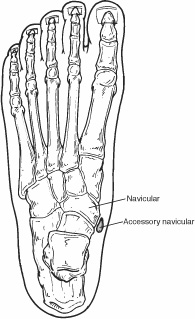What is Accessory Navicular Syndrome?
Accessory Navicular Syndrome can occur when a patient has a congenital abnormality called the accessory navicular. This is a small, extra piece of bone or cartilage on the inside of their foot, just above the arch. While this extra piece of bone usually goes unnoticed by people who have it, it can occasionally cause problems. These symptoms can be caused by trauma (e.g. sprains), excessive activity, or irritation from your shoes rubbing against the extra bone. Many people with accessory navicular syndrome also have flat feet, which puts more strain on the posterior tibial tendon (the tendon that runs along the back of your shin bone). This can lead to inflammation or irritation of the extra bone.
Signs and Symptoms of Accessory Navicular Syndrome
Accessory navicular syndrome usually first occurs at a young age, when our bones are transitioning from cartilage to bone. However, in some patients, symptoms might not appear until well into adulthood. These symptoms might include swelling, skin irritation, a bony prominence visible on the inside of your foot, redness, and pain and throbbing in the midfoot and arch, usually during or after extended periods of activity.
Diagnosis
To diagnose this syndrome, the podiatrist will ask about any symptoms you may be having, as well as examining the foot itself. They may also examine foot structure, muscle strength, joint motion, and the way you walk. If the doctor suspects that you have this condition, an X-Ray will likely be ordered for confirm the diagnosis. If you have pain or inflammation, an MRI or other imaging study might be ordered for further evaluation.


